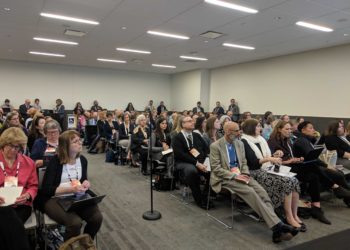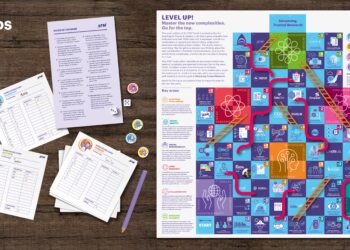Editor’s Note: Today’s post is by Paul Killoran. Paul is Founder and CEO of Ex Ordo.
In responding to the challenges posed by the global pandemic, scholarly conference organizers have had to adopt new tools and formats at an unprecedented rate. As the immediate impact of the pandemic gives way to a new sense of normal, scholarly societies have a unique opportunity to use the lessons they have learned to design an inspiring new future for their events. In doing so, it’s essential that the decisions they make are grounded in a deep understanding of the value their communities derive from these events.
Innovation Born of Necessity
For as long as scholarly societies have existed, their events have provided the true social network of academia; a place to connect, discuss ideas with colleagues, and share the results of their work. Conferences have always been at the heart of scholarly communities and they meet a need that is unmatched anywhere else. However, for much of recent history, scholarly conferences have been an under-appreciated sector within the scholarly communications landscape, failing to receive the level of attention and investment required to keep pace with the evolving needs of scholarly researchers.
While scholarly journals have often been criticized as being overly reliant on outdated processes and resistant to change, the truth is that nearly every facet of scholarly journal publishing has undergone tremendous change over the past 20 years. The nearly ubiquitous use of online peer review systems, machine readable metadata and license information, standardized XML formats, DOIs, ORCIDs, plagiarism detection tools, A&I databases, and the online availability of virtually all published content has transformed the production and dissemination of scholarly journals and made them available to a global audience of authors, editors, reviewers, and readers.
In contrast to the online availability and global reach that scholarly journals have achieved over the past 20 years, most scholarly conferences have continued to exist in an ephemeral state, limiting their impact to the relatively small group of participants who can be in the same building together for a few days each year. Even in cases where the papers from a conference are published in a formal conference proceeding, the valuable presentations and interactive discussions that take place during a conference are rarely captured as part of the scholarly record or made available to the countless researchers who could benefit from them. Moreover, the significant financial, political, and logistical hurdles of international travel have made it nearly impossible for many researchers to take part in the conferences most relevant for their field of research.
Starting in 2020, everything began to change. As a result of the significant challenges caused by the global pandemic, scholarly event organizers were thrust into a period of radical change that has the potential to permanently reshape the future of scholarly events. In the early days of the pandemic, event organizers rushed to transition their in-person events to a virtual format using whatever tools they could find. Once the immediate impact of the pandemic began to subside, there has been an understandable desire to return to the face-to-face interaction of a traditional conference format. However, there has also been a growing recognition of the numerous costs and limitations that are inherent in a purely in-person conference format, both from scholarly conference organizers as well as from the communities they serve.
Throughout this period, discussions about the merits and limitations of in-person and virtual events have tended to frame things in a rather binary way, which is unsurprising given how abruptly the traditional conference format was turned on its head. However, a careful look at the strengths and weaknesses of both in-person and virtual formats makes it clear that they each have something unique to offer and can play an important role in the future of scholarly events. The challenge now is to find the best ways to combine the serendipity and authentic human connections that so often take place at in-person events with the global reach and frictionless dissemination that online platforms can provide, all while working within the numerous constraints scholarly societies must face.

A Climate Emergency
For many people, the delight of emerging from the pandemic and the prospect of returning to in-person events has been tempered by the growing realization that we are facing a climate emergency. While the pandemic was (relatively) short lived, the corrective actions required to mitigate a climate disaster will be far reaching, particularly for the events industry.
Unless we can find an alternative to the conventional jet engine, history will not judge kindly the practice of flying thousands of people across the world into a convention center for a large annual meeting. A sustainable future for scholarly events will likely mean shifting towards smaller and more regional events in the physical world, connected together with online tools that can provide a global reach without the environmental impact of long-distance air travel.
The precise shape these new event formats will take is likely to vary a great deal between different disciplines and geographies. However, it’s becoming increasingly clear that it is no longer sustainable for any society with a large and geographically distributed membership to rely on one large annual meeting to bring people together in a single location.
Hybrid to the Rescue?
Current debates often compare the merits of in-person and virtual conferences, and for many people, hybrid events appear to be the obvious solution that can provide the best of both worlds. Yet, there is no single definition of what a hybrid conference means in practice, and no clear gameplan for how societies can adopt a hybrid strategy that is suitable given their specific needs and the resources available to them.
People often assume that the only way to run a hybrid event is by livestreaming an entire conference in real time, seamlessly connecting both an online and in-person audience throughout the event. While livestreaming an entire conference clearly has its advantages, the costs and staffing requirements needed to make this work are likely to be prohibitive for many scholarly conferences. Fortunately, a range of hybrid formats are starting to emerge that use a combination of live and pre-recorded presentations, synchronous as well as asynchronous discussions, and smaller in-person gatherings focused on networking and discussions as a means to reduce cost and maximise value for all participants.
At Ex Ordo, we saw a great example of how innovative new formats can be used in the early days of the pandemic when a long-time customer of ours wanted to try a virtual conference format that would prioritize the quality of discussions between participants above all else. Going against the grain of live presentations, they decided to experiment with a “flipped conference” model using pre-recorded presentations to their advantage. Attendees were able to log onto our system in the morning to watch the pre-recorded presentations on demand, returning later that afternoon to participate in live Q&A sessions.
There were initially some fears that nobody would turn up to the afternoon discussions, but instead the opposite happened. These interactive sessions were fiery and engaging, with all of the sessions running over time. The awkward tumbleweed of the session chair looking for questions had vanished now that the audience had an opportunity to digest the work being presented, prepare questions, and then engage in meaningful conversations with the presenters. These discussions then facilitated authentic networking interactions to occur outside of the sessions, allowing bonds to form around content and ideas rather than simplistic online profiles, keywords, and avatars.
Now more than ever before, societies are in a position to design innovative new formats for their events based on the specific needs of their communities as well as the resources available to them. However, in no way is this meant to imply that conference organizers find themselves in an easy position at this moment, since the choices they must make are fraught with uncertainties, complexity, and costs.
A Mind Shift
Event organizers are not alone in having to re-imagine the foundations upon which their businesses have traditionally been built. CEOs, COOs, and HR professionals are still trying to figure out what the future of work will look like for their organizations. Much as in the case of scholarly events, there is no single model for hybrid or remote work that will be appropriate for all organizations.
It would be naive to assume that creating an effective hybrid workplace is simply a matter of giving your employees a laptop and a Zoom license. The answer does not lie with technology alone; instead, organizations need to re-imagine their work practices and thoughtfully engage in the process of designing a new organizational architecture that will best support their teams in the years ahead. The same is true for scholarly conference organizers. In order to serve the future needs of their communities, the starting point must be to engage in the same sort of thoughtful reflection and experimentation that many remote-first and hybrid organizations are now beginning to take on.
In this process one thing is clear; scholarly societies must take the lead when it comes to defining the tools and formats that will best serve the needs of their communities. Form follows function and the needs of one scholarly community are likely to differ in important ways from those of another. Societies must first have a clear understanding of what they are aiming to achieve through their events and what unique needs and constraints their communities have. Only then will it be possible for a technology provider to deliver the tools and services a society will need to bring their vision for the future into reality.
Investing in Innovation
Many scholarly societies are facing a difficult financial position at this moment, both because of the pressure that open access has put on their publishing revenues and because of the disruption the pandemic has caused to their event revenues. Aside from the direct income that societies generate from their events, scholarly conferences have also served as an important means of building relationships with new and existing members and supporting many of the other activities of the society. Without the community engagement that takes place at their events, societies risk losing the connection they have with their members and undermining the other value-added services they provide.
However, it’s not all doom and gloom. Running large in-person conferences has always been high risk, and the significant hotel, travel, and catering costs of these events have been a major financial barrier for both organizers and participants. The pandemic showed us that by leveraging online tools to reach a global audience, societies have the ability to connect with researchers around the world who would have otherwise been unable to attend in person, creating opportunities for societies to expand their reach and membership in the years to come.
This isn’t meant to suggest that the road ahead will be easy. The investments societies will need to make in the short term as they deepen their understanding of their members’ needs, experiment with new event formats, and deploy new tools and platforms will likely take time before they will result in new revenue streams, cost savings, and membership growth. However, it is only by taking on this challenge head-on that societies will be able to create an inspiring and sustainable future for their events in the years ahead.
Discussion
3 Thoughts on "Guest Post — An Inspiring and Sustainable Future for Scholarly Events"
Great article Paul, right on the button!
At EASE, we are about to run our second hybrid conference following two virtual ones during the pandemic. It is double the work and at least double the cost, but it is likely to be the new normal.
Two of the ideas you put forward are very much on our radar – regional in-person events and pre-recorded sessions with live Q&A/discussion after. I’m optimistic about these, so fingers crossed they will work for us as they did for you
Adding to these useful insights, we are trying to figure out what we have learned from our two hybrid Researcher to Reader Conferences in 2023 and 2022 (and online in 2021). Of course R2R is not a ‘scholarly society conference’ itself but it is in a sense a meta variant, being about scholarly communications.
The February 2022 event, taking place as the pandemic was subsiding, was intended to be a fully-live and highly interactive hybrid meeting, rather than just physical lectures that were visible to online viewers. Registration and participation was 50:50 online and physical, for both delegates and speakers, and felt like a real hybrid meeting, with good levels of interaction between the online and physical people, facilitated by the careful event design and appropriate interactive technology. This was very expensive to deliver, due to the high preparation workload, the technology costs and the need for a skilled AV team, but it felt like it was working and worthwhile.
For 2023, we offered the same fully-live and highly interactive hybrid meeting, but online delegates were more like 20% of the registrations and 10% of the active participants, as many more people opted to come to the physical venue (in record numbers for R2R). Active participation by online delegates was negligible (with a few heroic exceptions), despite a similar investment in capability. We think this was mainly due to two factors. One was just a problem of a lack of ‘critical mass’ of online people. I’m sure many of us have been in a meeting where most people are physically in the room, and the one or two online attendees just can’t get traction (and attention) as full participants in the conversation. The other problem, we think, is that so many of the people who love to interact – asking questions and expressing opinions – who had been obliged to be online in 2022 were now attending physically in 2023. Our 2023 online cadre seemed to be mostly made up of people who were content to take a more passive role.
Our policy of charging one price for a hybrid ticket may have been a factor in our online numbers, as many people have an expectation that online will be cheaper, but the costs of delivering a real online/hybrid experience are high, and we were aiming to provide the same amount of value to both cohorts. Our survey feedback was that 91% of physical attendees rated R2R as good value for money, compared with 78% of online attendees.
Other feedback from our delegate survey (with an over 30% response rate) was generally very supportive of the principle of hybrid, but there was quite a lot of criticism of how it works in reality. Some was fair criticism of our implementation, but mostly it was numerous people telling us that full hybrid just isn’t viable in practice.
We now have some challenges as we plan for 2024, having spent around an additional £45,000 and 250 days over the past three years learning about hybrid and online.
With our current live hybrid format, I don’t think we can expect to attract a lot more online attendance, even if we were to reduce the relative cost of this very significantly, which seems unfair to physical participants, who would be subsidising the preparation, technology and AV costs. I’m also concerned that even with more online registrations, we would not get the level of interaction that makes R2R an interactive meeting, rather than a bunch of lectures.
I’m somewhat inspired by some of the innovation that is taking place, including Paul’s ideas in his post. Somehow uncoupling the content from the conversation, making the former more passive (available online) and the latter more active (and potentially still hybrid), might be an option, but it does not seem very consistent with the R2R ethos. We will have to explore this further as we plan for February 2024. But at the moment I am thinking that we may have to accept that the majority of our online delegates will not really want to be, or feel able to be, an active part of the conversation (and not at full price), so we may need, with considerable regret, to move back to a primarily physical format, albeit perhaps while retaining the ability to have some online speakers and panellists. This despite the obvious impact on the promise that hybrid gave us of improved accessibility and lower environmental impact.
I would love to hear from people who wanted to contribute to our thinking over the next couple of months, either by contacting me (or our Advisory Board members) directly, or by commenting on the R2R Community Forum.
I have just received a mailshot from a hybrid conference production company that is offering a revenue share model to help organisations to commit to going hybrid. To quote them: “We underwrite the extra costs, you and we agree a share of revenue from the online delegates, if it works you get a profit share, if it doesn’t, we take the loss and you find out important things about your audience.” This is certainly an interesting proposition for people afraid to make the hybrid leap, and suggests greater confidence in online revenues than I currently have!



